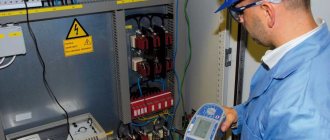The activities of modern production, various organizations, shops and public catering establishments are inextricably linked with power supply and electricity consumption.
Every day we have to come into contact with computers, office equipment, electrified tools, equipment, and to ensure that everything works safely and there is no injury from electric shock, trained personnel are required.
For this purpose, it is necessary to assign electrical safety groups, distinguishing between possible contact with an electrical installation and responsibility for the safe performance of work.
In this note, we will look at what qualifications exist, how assignments are made, what training is required, and if you have anything to add, write about it in the comments, this is important both for the author and for other readers.
Electrical safety groups
Electrical safety training should be built at any enterprise, clause 1.1.2 and clause 1.2.2 of Order of the Ministry of Energy No. 6 “On approval of the Rules for the technical operation of consumer electrical installations.”
This responsibility is assigned to employers, because electrical injuries are small compared to other industrial injuries, but when compared with severe or fatal outcomes, they occupy one of the leading places. Moreover, these accidents occur when working in electrical installations with voltages up to 1000 V. The reason is that they are very common and plus improper handling due to the relatively low level of training of operating personnel.
And in order for there to be fewer injuries at work, it is necessary for those in charge to know and understand what the Rules for the Technical Operation of Consumer Electrical Installations require of them, and it is worth starting to understand it with the electrical safety groups.
Electrical safety groups are systematized requirements for the qualifications of personnel who will need to undergo training in the form of instruction or certification, and there are a total of 5 electrical safety groups.
Such a distinction is necessary to ensure the safety of workers during ongoing work in the organization, or when involved in work in electrical installations, depending on the training of personnel.
1 group on electrical safety
1 qualification group for electrical safety is assigned only to non-electrical personnel who are not directly related to the maintenance and operation of electrical installations. But during their workdays, they may be exposed to electric shock due to improper handling of electrified equipment.
In any organization there are always employees who are assigned group 1 for electrical safety and these are, as a rule, office workers, loaders, janitors, cleaners and all those who have absolutely nothing to do with electrics in this organization.
Assignment to group 1 in electrical safety takes place in the form of training in the organization, many call it instruction, correctly, so and so. Because everything goes without any special difficulties, it is carried out by the person responsible for electrical equipment or another employee with an electrical safety group of at least 3, who is appointed by order for the enterprise.
He talks about observing safety measures when working with equipment, for example, a computer, office equipment, coffee machine, and the rules for providing first aid in case of electric shock.
At the end, questions are asked and if the person being instructed has coped, the result is recorded in the logbook and assignment of 1st electrical safety group. The frequency of such knowledge testing is once a year. And that’s all, no protocol or certificates are required.
If you want to understand in more detail the assignment of electrical safety group 1, follow the link to another article.
What are the electrical safety clearances for welders?
To use electric tools (an electric welding unit belongs to the category of electric tools), PTEEP came up with a special category of personnel and called it “electrotechnological”. It is also assigned for working with angle grinders, for operating electric concrete mixers and for many other electrical appliances that pose a danger to workers in operation and require separate training.
Welders are also assigned groups depending on the work performed.
If the electric welder simply operates the unit, then he only needs Group II approval for electrical engineering personnel.
Specialists who, in addition to directly using electric welding equipment, also connect it to the network and also perform maintenance, must be assigned electrical safety group III.
For maintenance and repair, it is recommended to assign the employee the title of electrician and operational repair personnel. This way you will “kill two birds with one stone” - there is no need to hire a separate specialist for repairs and maintenance. Accordingly, the third group must be assigned to welders performing work in hard-to-reach or confined spaces, as well as observing persons (there must be at least two observing employees, it is enough to assign a group to one, they must always be outside).
Full range of occupational safety services
Enter your phone number and I will calculate an estimate for your tasks. Enter without the eight. “Ekaterina Vorontsova’s Bureau” is a professional solution to your occupational safety problems. High quality and on time!
Group 2 on electrical safety
The next increasing level of qualification is group 2 in electrical safety. And assignment is required to personnel who work using electrically driven equipment.
These employees usually include:
- electric welders, without connection rights;
- lifting equipment operators;
- lifters;
- drivers from different industries;
- electricians and electricians who have access to installations up to 1000 V.
- employees who missed group assignment for more than six months.
If an employee is undergoing certification for Group 2 in electrical safety for the first time and has no electrical engineering education, then he must first undergo 72 hours of training. If the enterprise has a knowledge testing commission, then certification is carried out locally.
If there is none, then certification takes place in Rostechnadzor, and pre-certification training in a training center.
Group 2 training in electrical safety conveys to the employee knowledge about the threats, dangers and consequences of improper work with electrical equipment and electrical installations.
This knowledge must be conveyed realistically and in fact, otherwise, such cases as my good friend told me are possible.
A small contractor came to the site to clean the split systems. Apparently, they had a lot of work, it was summer, they were in a hurry, trying to finish the work for the day. Several of the air conditioners were located at a height of 2 floors. For the work they used a Karcher and a ladder. Forgetting to first turn off the power to the split, I started work.
My acquaintance
The result of such work is multiple fractures after a fall from a height due to the surprise effect of the closure.
You need to work safely at heights, and even more so with electrical equipment, otherwise the result can be even worse. And all due to the lack of knowledge of workers about the safe performance of work.
Group 3 on electrical safety
An even more “advanced” level of qualification is group 3 in electrical safety. The assignment is the same as for group 2. Moreover, a promotion from group 2 to group 3 cannot happen instantly; there must be a time interval in order to gain knowledge and experience.
This interval ranges from 1 to 3 months, depending on education (Appendix No. 1 Order of the Ministry of Labor No. 903n), because knowing Ohm’s law does not mean that you can immediately work in electrical installations.
And if the employee has a confirming certificate, then he can independently carry out maintenance, connection or disconnection, as well as inspection of electrical installations up to 1000 V.
And now he has not only the technical side covered, but also the organizational one, because he can already be part of a team that carries out work on electrical installations of more than 1000 V, observe and remember how approval is carried out before performing such work.
If work is carried out in installations up to 1000 V, then an employee who has a 3rd electrical safety group can act as a team producer. This is already a big responsibility, because you have to answer not only for your own actions, but also for the actions of your colleagues.
That is why group 3 for electrical safety is assigned only to persons over 18 years of age, in contrast to groups 1 and 2 for electrical safety.
Group 4 on electrical safety
Electrical safety group 4 can only be assigned by the Rostechnadzor commission, because the range of responsibility is much wider.
It can perform the functions:
- operational and repair personnel;
- manufacturer or permitting work on electrical installations;
- instructing, interning and training in electrical safety.
And in order to receive the “coveted” crust, an employee must work in group 3 in electrical safety for 2 to 6 months.
5 electrical safety group
As a rule, group 5 on electrical safety consists of purely administrative and technical workers who have maximum responsibility, issue work permits, act as the person responsible for electrical facilities and can be the supervisor of work in any electrical installations.
The knowledge base is already voluminous; there must be a thorough knowledge of electrical safety rules, regulations, rules for the use and testing of protective equipment, reading electrical equipment diagrams and layout, and much more. The list is very extensive and you can move from level 4 electrical safety group to level 5 group in a period of 3 to 24 months.
And as it is already becoming clear, you can increase your group only by passing certification at Rostechnadzor.
How can welders obtain an electrical safety permit?
Electrical safety is a “supervised” thing, and it’s impossible to get an inspector’s approval (unless, of course, it’s a special certificate, or the organization has its own commission). It is also impossible to come to supervision on your own and get it - a specialized training center that has a training license and an agreement with Rostechnadzor sends there (documents or the person himself, it doesn’t matter).
Based on the above, there are two ways of registration:
- 1. Send the welder to an educational institution to undergo training independently. It will take a month to complete the proctored exam.
- 2. Obtain an electrical safety permit for welders with our help. The entire procedure with minimal disruption from production (maximally remote). We provide all materials and answers to tickets. As well as full documentary support.
In both cases, the employee receives a certificate with an entry in the electrical safety knowledge test log (supervision). The resulting assumption will need to be confirmed annually.
Main conclusions
Finally, I will give you a summary of electrical safety groups:
- Group 2 up to 1000V;
- Group 3 up to 1000V;
- Group 3 up to and above 1000V;
- 4 group up to 1000V;
- Group 4 up to and above 1000V;
- Group 5 up to and above 1000V.
So, having briefly examined all the groups on electrical safety, let’s draw a line and define the main points:
- It is impossible to skip over one electrical safety group; a gradual increase is required with working in each of them for a certain time.
- You can “reach” electrical safety groups 2 to 5 in 1 year, this is as quickly as possible, taking into account the employee’s higher electrical engineering education.
- Only persons of groups 2 and 3 in electrical safety are allowed to undergo certification by the commission of their enterprise, if there is a commission to test knowledge of electrical safety in the organization.
Working in electrical installations is a source of increased danger and to ensure the safety of workers, it is necessary to regularly provide training, improve their practical knowledge and skills to reduce the likelihood of serious injury and death.
Therefore, if your organization has created a commission on electrical safety, conduct actual training for groups 2 and 3, and do not assign them groups for “beautiful” eyes.
I wish you safe and efficient work!
If you have any questions or have something to add or supplement, write in the comments, this is important for both the author and the readers. If you need help with paperwork, please contact us.
Conducting training for welders
The procedure for performing welding using electrical equipment is regulated by the provisions of Order No. 6 of the Ministry of Energy. This regulatory document in paragraph 1.4.3 establishes that this type of activity is classified as complex along with electrolysis, electrothermal and other special operations. This means that only specially trained electrical personnel are authorized to carry out such work. Specific requirements for the level of such training are specified in paragraph 3.1.15 of this legal act. This section of the order determines that in order to obtain permission to carry out work, an electric welder must undergo:
- instruction on the procedure for performing the necessary work;
- training in the field of electrical safety during labor operations;
- checking the level of acquired knowledge and skills;
- the procedure for assigning the required group with the issuance of the corresponding electrical safety welder certificate.
Electrical safety requirements for welding equipment
An electric welding installation (welding transformer, unit, converter, rectifier) must have a passport, operating instructions and an inventory number under which it is recorded in the logbook and periodic inspections.
Transformers, rectifiers and direct current generators specially designed for this purpose can be used as sources of welding current. Direct supply of the welding arc from the power (or lighting) workshop distribution network is not allowed. Welding-type sources can be connected to electrical distribution networks with a voltage not exceeding 660 V. The load of single-phase welding transformers is evenly distributed between the individual phases of a three-phase network.
In mobile electric welding installations, to connect them to the network, it is necessary to provide for blocking switches, eliminating the possibility of connecting and disconnecting the wire when the clamps are energized.
Electric welding installations must be connected to and disconnected from the electrical network, and repaired only by electricians. Welders are prohibited from performing these operations. The length of the primary circuit between the power point and the mobile welding unit should not exceed 10 m.
Current-carrying parts of the welding circuit must be reliably insulated (insulation resistance must be at least 0.5 MOhm) and protected from mechanical damage. The insulation resistance of the electrical circuits of the installation is measured during routine repairs in accordance with GOST for operating electric welding equipment. The timing of current and major repairs of welding installations is determined by the person responsible for the electrical equipment of the enterprise, based on local conditions and operating conditions, as well as the instructions of the manufacturer. The installation and its starting equipment should be inspected and cleaned at least once a month. All open parts of the welding installation under mains voltage are securely fenced.
The insulation resistance must be checked at least once every three months, and for automatic submerged arc welding - once a month. The insulation must withstand a voltage of 2 kV for 5 minutes.
The housings of electric welding equipment are grounded (grounded). For protective grounding (grounding) of the housing, power supplies equipped with special bolts are connected to the wire of the grounding (grounding) device. In this case, each welding installation must be directly connected to the neutral (grounding) wire. Serial connection of installations to each other and the use of a common neutral (grounding) wire for a group of installations is not allowed. Failure to comply with this requirement may lead to the fact that if the wire connecting the units in series breaks, some of them will not be zeroed.











